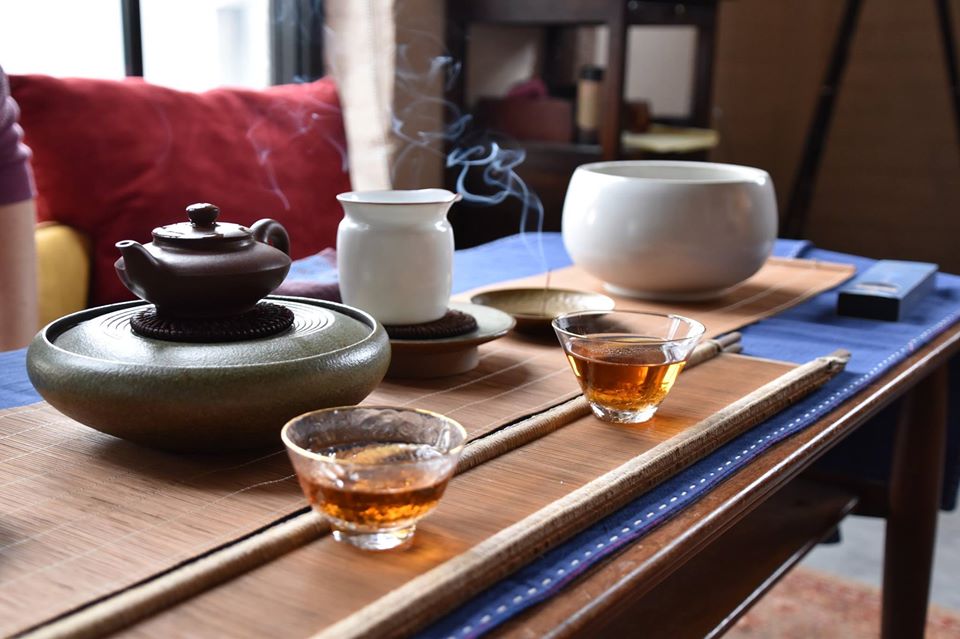Gongfu Tea is best translated as “Leisure Tea.” It is a beautiful way of preparing and enjoying tea alone or with guests that is designed to immerse you in the tasting experience and help put you in a mindset to truly appreciate the simple perfection of tea leaves in water. Gongfu can take many forms, from an impromptu outdoor tasting with friends to a highly ritualized formal ceremony with deep connections to Taoism, Buddhism and meditation.
At heart, all gongfu is the same. The core of gongfu is yielding and flexibility. The ritual can never stand in the way of enjoyment. It is meant to be bent and re-envisioned to create a comfortable, quiet and contemplative environment no matter what. Even the formal Japanese Chado breaks down to two fundamental rules:
- Make good tea
- Make your guests comfortable and at ease (even if your only guest is you!)
In China, these rules are followed by embracing an adaptable ceremony. Sometimes tea will be prepared in glass, sometimes porcelain or yixing. Tea can be made outside or indoors, with music and incense or on its own. The most iconic and consistent element in most Chinese gongfu tea is the tea board.
A tea board is an immediate giveaway that a tea set is configured around Chinese gongfu principles. It is an old tradition that you see in almost any teahouse in China. We love using tea boards, and the sense of drama they can add to ritual by creating a stage. However, we also have some problems with tea boards.
They take up a lot of space. They can be very heavy. They are easy to forget to empty and clean. But most importantly, we are hesitant to embrace the tea board for the very reason we love them. Tea boards frame off gongfu tea. They separate it from the rest of our surroundings. We love the aesthetic drama, but we often find ourselves craving something more modern and approachable, a true gongfu set up that feels integrated into our home, that can be arranged with all the other things we love. We want something that feels more alive and inviting.
Gongfu tea has always been centered around adaptability and yielding. It is a tool of appreciation, not an untouchable relic. The way we live has changed. We don’t all have formal halls just to receive guests. We combine work space and living space, we travel, we simply live differently.
Luckily, Chinese designers, tea ceremony practitioners and teachers, and the scholarly leisure class have been moving towards a new gongfu set up. This setup is elegant, fluid, and supremely integrated with the space around it. The elements of this new gongfu style has been around for some time, and now it is no surprise to see the style really taking off and growing in popularity.
Here’s how Modern Gongfu works.
First, a surface is chosen for tea. This could be a table, the floor, a rock – anything. For a feel that hearkens back to the Song Dynasty scholar’s studio, a runner is put down. The runner brings the rich history of Chinese textile arts into tea ceremony, and makes the space more neutral and ready to receive beautiful objects. A pop of color can set the tone.
Next, stands and tea boats are placed. A tea boat is a stand with a very small reservoir, a sort of mini tea board for a single object. This tea boat is important when yixing pottery is in use, as it allows you to pour a single steeping over the pot without spilling on your table or runner. The boat can just as easily hold a gaiwan or pitcher and simply act as a beautiful saucer.
For tea without yixing pottery, stands can also be used. A stand is a great complement to a tea boat to hold a pitcher. The stand catches small drips, but it also places your pitcher of tea ‘on a pedestal’ so that the beauty of the object and the color of the tea can be admired.
Once you have your tea boat, tea pot, pitcher and stand, the critical water bowl is added. The water bowl is the biggest departure from old school gongfu. The water bowl exists to pour extra tea into. It takes the place of the tea board as a reservoir. Using a bowl instead of dumping on a board creates a much cleaner space, emphasizes the intentionality of brewing tea, and is much easier to carry to a sink to drain. Using a bowl makes the entire setup flexible. You can carry the bowl and other gear to any room, or wrap it up to take outdoors. You don’t need to be tied to wherever a heavy tea board happens to be installed.
As a reminder of tea’s connection to the outdoors, choose a vase and add an arrangement of flowers, plants, or even beautiful sticks. This tradition connects back to Song scholarly studios’ emphasis on beautiful imperfect objects. It is also a piece of shared heritage with Japanese Chado, where a flower arrangement is just as critical as the cups used for sipping tea.

Finally, coasters are placed for each cup to catch any drips and elevate your beautiful cups for appreciation. Long thin trays or group coasters can also be set on the table, especially when many guests are seated together on one side of the tea table. Coasters are also often placed under tea pots and pitchers, both to catch drops and to protect all of the surfaces from scratches. Accessories such as strainers or lid stands can be added for convenience when needed.
Each piece in the modern gongfu set up is interchangeable. You can pair any piece in your collection with anything else and continue to evolve your setup. While the tea board can often visually steal the show and overwhelm the quiet beauty of a teapot or porcelain gaiwan, the visual star in a modern gongfu setup is the brew vessel, along with the pitcher and cups. The modern set up lets your collection shine.
The entire set up is designed for flexibility, easy clean-up, and of course, makes a striking visual statement. The style is pulls inspiration from the Song Dynasty, both from the scholarly studio with featured objects of contemplation, and from the ceramics style of large coasters and stands for tea and wine bowls. Best of all, a gaiwan can be swapped for another vessel and the setup is just as appropriate for Japanese tea, or with larger vessels, even formal english tea. The modern style crosses cultural lines and achieves graceful relevance in the modern home.
We are excited to see this new style taking off in China and hope that it is the beginning of a great tea and tea ware renaissance. We are excited to see how artists across China adapt their tea wares to respond and improve, and look forward to supporting and sharing their work for years to come.


 How To
How To Myths & Legends
Myths & Legends Travelogue
Travelogue Tasting Journal
Tasting Journal Talking Shop
Talking Shop Tea 101
Tea 101 Watch
Watch Teaware
Teaware News
News












Leave a Reply